Guitar, keyboard, or drums: which one fits your style?
I guide you with a simple style and budget checklist, matching your goals to the time you can practice. I compare learning curves, teach easy techniques for each instrument, build short practice routines for steady progress, pick budget gear and a home studio setup, show quick tone tweaks and simple songwriting moves, and track progress with clear goals so you can choose the right path.
Guitar, keyboard or drums fit your style — Key takeaway
- Try guitar when you want to sing and lead.
- Choose keyboard to play chords, bass and arrange.
- Pick drums to drive the beat and energy.
- Test basics on each instrument to see what fits.
- Follow what feels fun to keep practicing — there are real mental benefits to playing music like the ones explored in music as therapy and how playing clears the mind. See the evidence on music benefits for mental health.
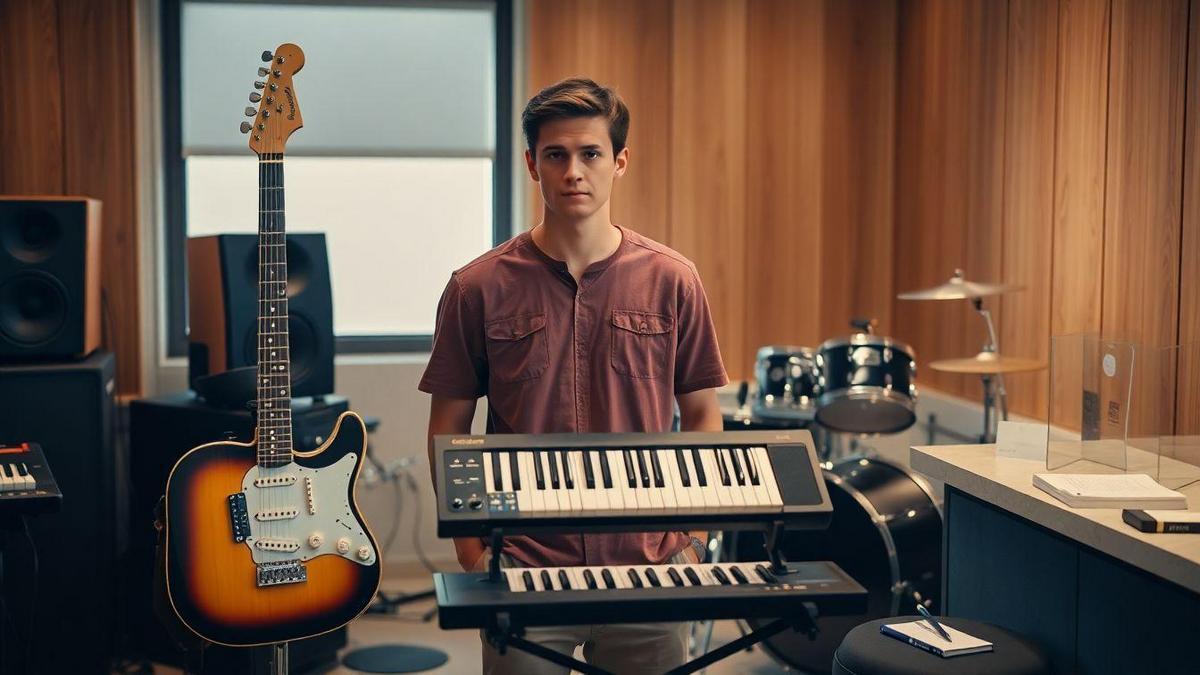
How I decide: Guitar, keyboard, or drums — for my budget and goals
Ask three simple questions: What sound do I love? How much money can I spend? How much time will I practice? Use short tests and quick math to pick faster — and if you want a step-by-step way to narrow choices, see the practical tips in how to choose your first instrument without regrets. For a practical external checklist to compare instruments, see how to choose a musical instrument.
Simple style and budget checklist
Write down your music style, budget, and noise/space limits.
- Style: rock, pop, electronic, jazz, or song accompaniment.
- Budget: low ($), medium ($$), high ($$$).
- Space/noise: quiet apartment or big house.
Starter cost and needs:
| Instrument | Typical starter cost | Space / noise | Quick skill curve |
|---|---|---|---|
| Guitar (acoustic) | $100–$300 | Low | Fast to sound good |
| Keyboard (MIDI/portable) | $100–$400 | Low | Good for songwriting |
| Drums (electronic starter) | $200–$700 | Medium–High (electronic pads for low noise) | Harder to sync timing |
A cheap acoustic taught me three chords in a week — that confidence kept me practicing.
Match goals to the time you can practice
List your goal, then pick the instrument that fits your available minutes per day.
| Goal | Practice/day | Instrument fit |
|---|---|---|
| Play for fun / campfires | 10–20 min | Guitar or Keyboard |
| Write songs / record at home | 20–45 min | Keyboard or Guitar |
| Join a band / gig live | 45–90 min | Drums or Guitar |
| Electronic music / beats | 20–60 min | Keyboard (with DAW) |
Small, clear targets beat vague plans. If you have 15 minutes daily, work on one chord or one riff. If an hour, split time: warm-up, technique, song.
Quick pick rules
- Fast results low noise → Guitar (acoustic).
- Love melodies and composing → Keyboard.
- Want to drive the band → Drums (electronic pads for apartments).
- Tight budget → start with a used guitar or small keyboard.
- Short practice time → choose Guitar or Keyboard over drums.
If your challenge is building consistent sessions, the approach in creating a simple daily practice routine is a great complement to the short plans above.
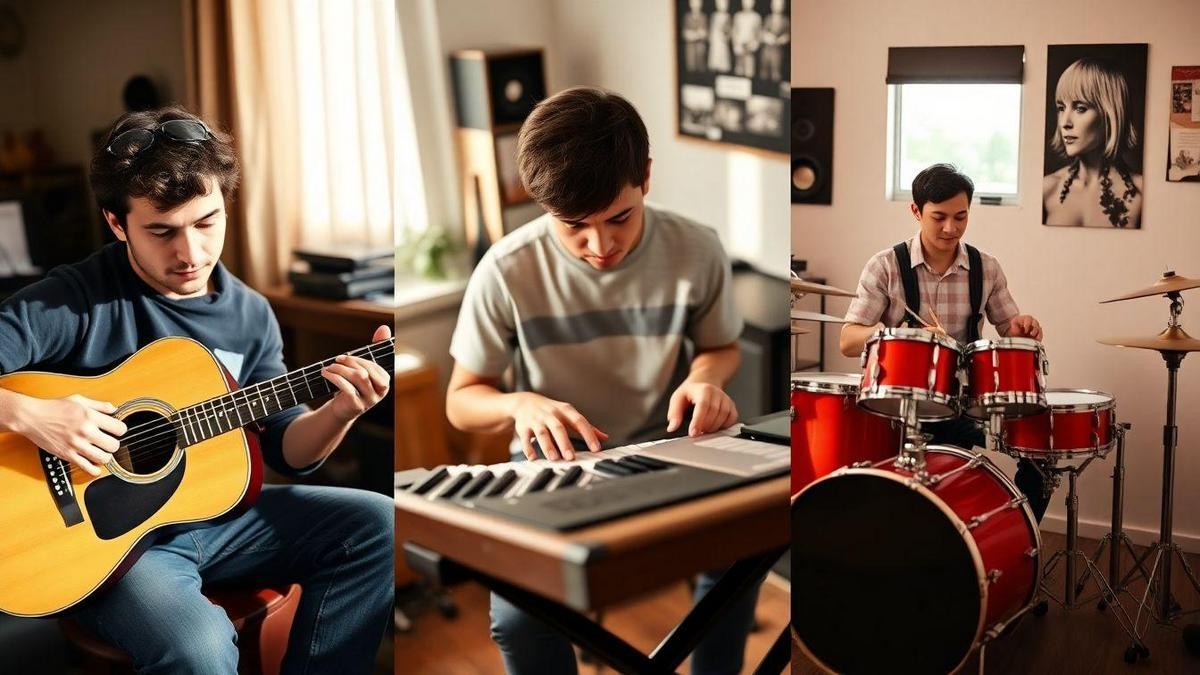
How I compare learning curves for guitar, keyboard and drums
I size up each instrument by ease of start, coordination needs, theory load, and time to play songs.
| Factor | Guitar | Keyboard | Drums |
|---|---|---|---|
| Ease to start | High — simple chords in weeks | High — single notes easy | Medium — simple beats fast |
| Coordination | One hand frets, one picks | Two-hand independence grows | Limb independence needed |
| Music theory | Chords and scales | Harmony and voicings | Patterns and time feel |
| Physical demands | Finger strength; early soreness | Finger reach, posture | Stamina and limb control |
| Play songs quickly | 2–8 weeks (simple songs) | 1–6 weeks (melodies) | 1–4 weeks (basic beats) |
If the idea of music theory feels daunting, the practical angle in music theory for songwriting shows how small amounts of theory can speed progress without killing creativity.
I tested by learning a three-chord song on guitar in a week, a pop riff on keyboard in three days, and a basic rock beat in two sessions — real practice gives real perspective.
Best beginner techniques — condensed
Electric guitar (beginners)
Start with posture and fret-hand placement. Daily moves:
- Power chords: two shapes to move around.
- Alternate picking: down/up with a metronome.
- Palm muting: change tone quickly.
- Open chords: E, A, D, G, C — switch slowly.
- Simple bends: aim for accurate pitch.
Sample routine:
- 5 min warm-up chromatic runs.
- 10 min chord changes.
- 10 min riff/song.
- 5 min metronome speed work.
Consistency beats long, infrequent sessions.
Piano / keyboard improvisation (beginners)
Keep it small:
- Learn C major scale and C major chord.
- Left-hand loop: C — Am — F — G.
- Improvise right-hand with the C major scale.
Use the pentatonic (C D E G A) for quick wins. Record one minute of improv daily.
Daily learning time guide
| Level | Guitar (min/day) | Keyboard (min/day) | Drums (min/day) |
|---|---|---|---|
| Beginner | 20–40 | 20–40 | 20–40 |
| Intermediate | 40–60 | 40–60 | 40–60 |
| Advanced | 60 | 60 | 60 |
One focused block each day (no phone, timer on): warm-up, technique, songs, cool-down.

How I build practice routines for steady progress
I ask one question: Guitar, keyboard, or drums: which one fits your style? That guides instrument choice and routine length. Treat practice like watering a plant: small, regular doses grow fast.
Drum routine for timing & groove
- Start with a metronome.
- Play simple hits on every beat, then add off-beats and fills.
- Record short takes, slow tempo when wobbly, speed up when relaxed.
- Use play-alongs to lock with music.
Acoustic fingerstyle approach
- Learn thumb pattern first for steady bass.
- Add fingers for melody.
- Isolate tricky parts and practice short patterns slowly.
- Count out loud and use song fragments to build muscle memory.
My 20-minute practice plan
| Minute | Focus | Goal |
|---|---|---|
| 0–3 | Warm-up (rubs, stretches, simple hits) | Wake hands and mind |
| 3–8 | Core drill (metronome work / thumb pattern) | Lock timing or bass |
| 8–14 | Technique (fills, finger patterns, chord shifts) | Build control |
| 14–18 | Song fragment (short phrase) | Apply the drill |
| 18–20 | Review (note one fix) | Plan next step |
Quick tips:
- Pick one clear goal each session.
- Use a timer and stop when the plan ends.
- Note one small win every day.
If you want a concise template to build from, the strategies in creating a simple daily practice routine pair well with the 20-minute plan above.
Gear and home studio on a budget
Ask: Guitar, keyboard, or drums: which one fits your style? Then buy gear that helps you play more, not collect dust. Favor portability, simplicity, and clear upgrade paths.
Record drums cheaply
- Minimal useful chain: kick, snare, two overheads.
- Overheads 2–3 ft above cymbals, slightly in front of snare.
- Kick mic inside hole or against beater; snare 1–2 in above rim.
- Check phase and set peaks around -6 dB.
- Treat room cheaply: blankets, rugs, foam.
- If no mics, use a single room mic or drum VST. For deeper mic choices and placement examples, see practical drum recording for home studios.
Quick mic plans:
| Rapidity | Mics | What you get |
|---|---|---|
| Minimal | 1 condenser (room) | Room tone, quick capture |
| Basic | Kick Snare 2 Overheads | Punch, clarity, stereo |
| Better | Add toms hi-hat | Full control in mixes |
Keyboard MIDI mapping & workflow
- Build DAW templates with named, colored tracks: Bass, Pads, Leads, Piano.
- Map controls (volume, filter, reverb) to knobs on your controller.
- Use split zones: bass left, chords right.
- Set velocity curves to match your touch.
- Use buffer 128 samples for tracking; 512 for large mixes.
- Record loops and drag into arrangement lanes.
MIDI mapping quick reference:
| Control | Typical assign | Why map it |
|---|---|---|
| CC1 (mod) | Filter cutoff | Live timbre changes |
| CC7 | Channel volume | Quick level tweaks |
| CC64 | Sustain pedal | Realistic piano |
| Pitch wheel | Glide / FX | Expressive moves |
Budget setup checklist
| Item | Why | Rough price (USD) |
|---|---|---|
| Audio interface (2in/2out) | Connect mics and monitor | $80–$200 |
| One dynamic mic (snare/kick) | Handles loud sources | $30–$100 |
| One small condenser (overheads/room) | Adds detail | $50–$150 |
| Headphones (closed) | Tracking & isolation | $30–$120 |
| MIDI keyboard (25–49 keys) | Play & map instruments | $50–$200 |
| DAW (budget/free) | Record & edit | $0–$200 |
| Cables & stands | Makes setup usable | $30–$80 |
| Room treatment (blankets/rugs) | Cuts reflections cheaply | $0–$50 |
Prioritize interface, decent mic, and headphones first.
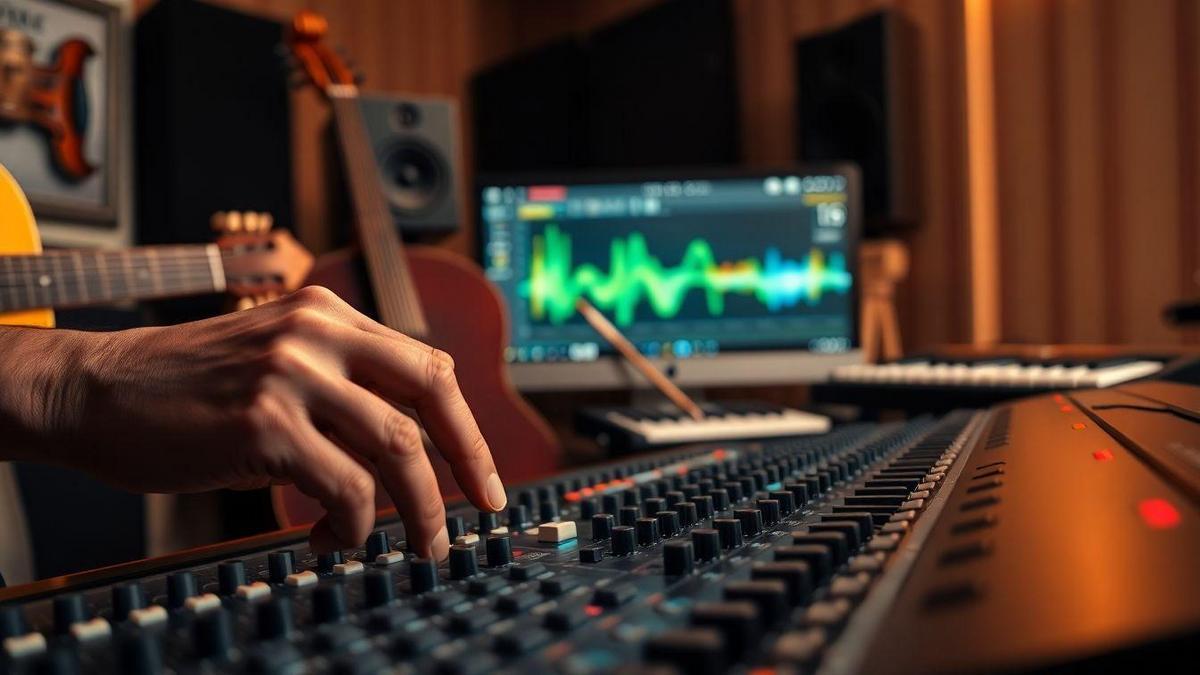
Tone, mic placement and quick fixes
Guitar amp settings — clean vs crunchy
- Choose amp channel: clean or drive.
- Use guitar volume knob to soften gain.
- Adjust EQ in small steps; trust your ears.
- Reverb for clean; less reverb for tight crunch.
- Pickup selection: neck = warm clean; bridge = bright crunch.
Starting points:
| Control | Clean | Crunch |
|---|---|---|
| Gain | 1–3 | 5–7 |
| Bass | 4–6 | 3–6 |
| Mid | 4–6 | 5–7 |
| Treble | 5–7 | 4–6 |
| Presence | 3–5 | 4–6 |
| Reverb | 2–4 | 0–2 |
Test at band volume — what sounds good alone may clash live.
Simple mic placement for drums
- Kick dynamic: 1–6 in inside hole for boom or near beater for click.
- Snare dynamic: 1–3 in angled at head for snap.
- Overheads (cond): 12–36 in above kit for cymbal clarity and stereo.
| Mic | Placement | Distance | What it brings |
|---|---|---|---|
| Kick (dynamic) | Inside or at port | 1–6 in | Punch / low-end |
| Snare (dynamic) | Angled at head | 1–3 in | Snap / attack |
| Overheads (cond) | Above kit, spaced/XY | 12–36 in | Cymbal clarity / stereo |
| Hi-hat (small cond) | Off edge | 6–12 in | Hi-hat detail |
Quick tone tweaks:
- Muddy → cut bass or move mics back.
- Thin → boost mids or bring mic closer.
- Harsh guitar → lower treble or roll back guitar volume.
- Cymbals dominate → lower overheads or add a high-pass.
- Snare lacks snap → tighten top head or angle mic to rim.
One change at a time; A/B test.
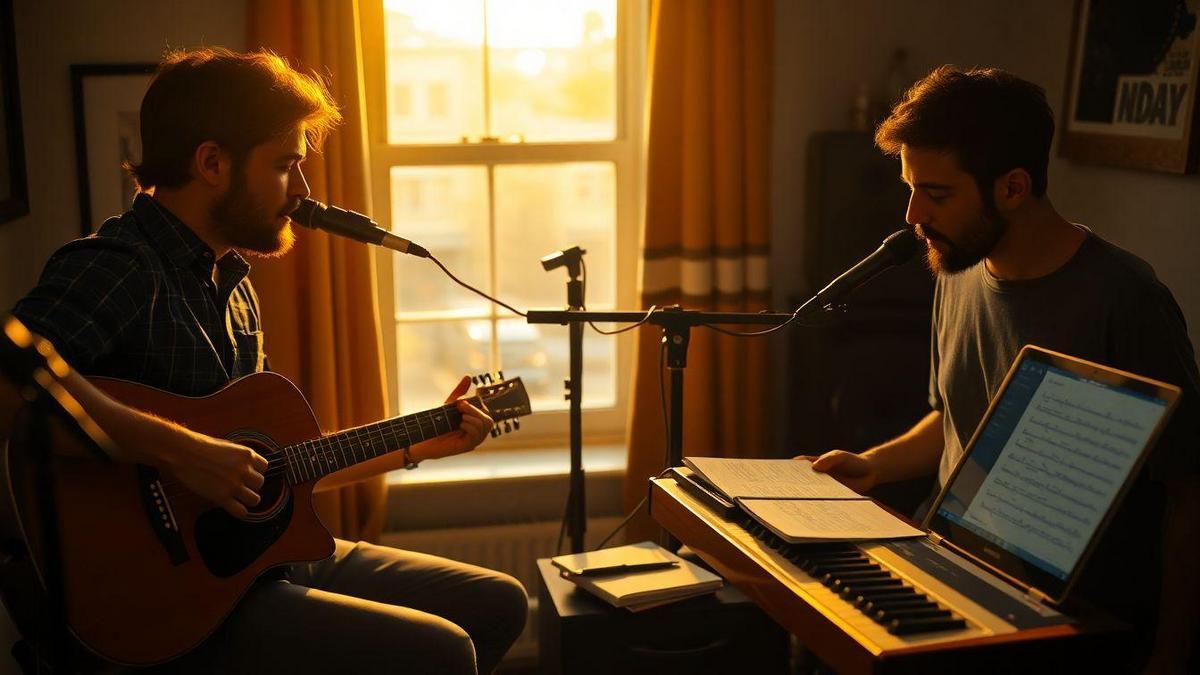
Songwriting and collaboration (guitar piano focus)
Start with a tiny idea: a short guitar riff or piano phrase. Test alone, then bring to a friend. Assign clear roles:
- Keep the melody and main chord idea.
- Partner adds rhythm, chord color, or vocal hook.
- Record quick demos on your phone.
Tool use quick tips:
| Tool | How I use it | Quick tip |
|---|---|---|
| Guitar | Sketch riffs, add rhythm | Play 2-bar loop and repeat |
| Piano | Map chords, find voicings | Try wide and close voicings |
| Both | Swap parts to find hooks | Let one instrument lead per section |
If you want to make songwriting less mysterious, the practical music-theory approach in is music theory really that scary for songwriters offers clear, applied tools for writing better songs. Berklee also gives practical tips for beginning songwriters.
Keyboard chord progressions for pop
Three simple progressions in C:
| Progression | In C Major | Mood | How I teach it |
|---|---|---|---|
| I–V–vi–IV | C–G–Am–F | Bright, pop | Block chords → arpeggiate |
| vi–IV–I–V | Am–F–C–G | Emotional | Emphasize bass change |
| I–IV–V | C–F–G | Classic | Use for verses/endings |
Simple song structure guide:
| Section | Bars | Role | My guide |
|---|---|---|---|
| Intro | 4–8 | Set mood | Use instrument hook |
| Verse | 8–16 | Tell story | Keep chords spare |
| Pre-chorus | 4–8 | Lift | Change chord or rhythm |
| Chorus | 8–16 | Main hook | Make it big & repeat |
| Bridge | 8 | Contrast | New chord or key shift |
| Outro | 4–8 | Close | Strip back or repeat hook |
Treat structure as a map, not a cage.
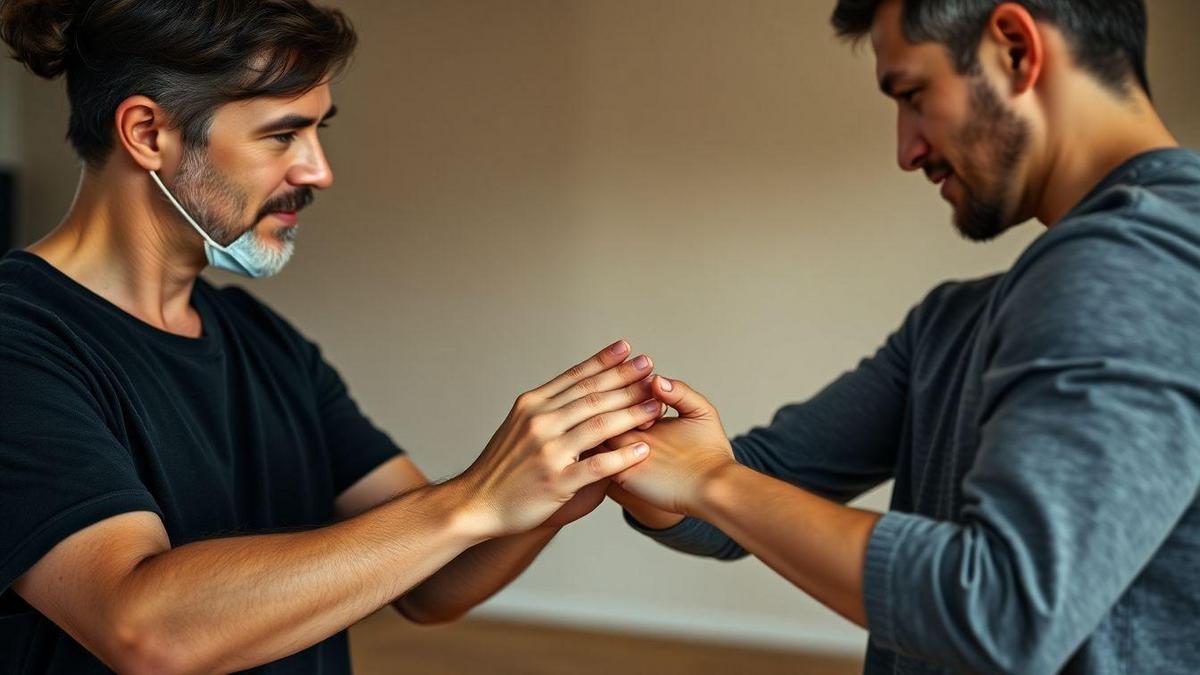
Core technique for lasting skill
Drumming rudiments & coordination
The Percussive Arts Society lists essential drumming rudiments and practice. Start with short, repeatable rudiments:
- Single stroke, double stroke, paradiddle, flam.
- Practice with a metronome. Add foot patterns for limb independence.
| Exercise | Trains | Time | Tempo start |
|---|---|---|---|
| Single strokes | Speed & control | 5 min | 60 bpm |
| Double strokes | Rebound control | 5 min | 50 bpm |
| Paradiddle | Hand switching | 7 min | 55 bpm |
| Flam | Accent & feel | 3–5 min | 50 bpm |
| Hands foot | Coordination | 10 min | 40 bpm |
Increase 5 bpm when reps are clean.
Guitar finger positioning & strumming control
Break the guitar into two jobs: fret hand and strum hand.
- Fret hand: use fingertips, arched fingers, relaxed thumb behind neck.
- Strum hand: grip, wrist motion, dynamic control.
- Add muting drills to clean up noise.
Drills:
| Drill | Goal | Time |
|---|---|---|
| Finger placement single string | Clean frets | 5 min |
| Chord change slow motion | Speed & accuracy | 7 min |
| Downstroke control | Even tone | 5 min |
| Up/Down alternation | Rhythm | 7 min |
| Palm mute & strum | Tone control | 5 min |
Technique warm-up checklist:
- Metronome on.
- Hands loose — shake out.
- Breath — deep breath before starting.
- Single-note warm-up 3–5 min.
- Rudiment/scale 5–10 min.
- Coordination drill 5–10 min.
- Finger/wrist stretch 30s each side.
- Slow song run-through 5 min.

Choosing between solo, band, and studio roles
Setlists & gear for solo vs band
Name the goal: mood, length, crowd size. Solo sets need to sound full alone (loops, backing tracks). Band sets leave space for dynamics.
Quick packing comparison:
| Item | Solo shows | Band shows |
|---|---|---|
| Set length | 30–60 min | 45–120 min |
| Song choice | Focused, loop-friendly | Arrangement-heavy |
| Gear weight | Light | Medium–heavy |
| Backups | Simple | Redundant |
| Stage map | You control | Coordinate with bandmates |
Practice / recording workflows
Weekly plan with short blocks:
- Solo: make songs sound complete alone; record phone demos.
- Band: practice parts that lock with others; bring charts.
- Studio: focus on precision, log best takes, note mic/plugin settings.
Workflow snapshot:
| Step | Solo practice | Band rehearsal | Studio session |
|---|---|---|---|
| Warm-up | 10 min scales/rhythm | 10 min groove | 10 min sound check |
| Focus | Song full-runs | Parts transitions | Multiple takes |
| Time block | 30–60 min | 60–120 min | 2–6 hours |
| Recording | Phone demos | Rehearsal capture | Multi-track files |
| Notes | Short notes | Shared charts | Detailed session log |
Live & studio tips:
- Pack spares (cable, strings, sticks).
- Label channels/pedals; bring a DI.
- Warm up away from mic.
- Use a click when required, but play musically to it.
Minimum live vs studio gear:
| Instrument | Live minimum | Studio minimum |
|---|---|---|
| Guitar | Amp, cable, tuner, spare strings | DI/amp, mic, spare strings |
| Keyboard | Stand, power, sustain, DI | MIDI/USB, DI, headphones |
| Drums | Sticks, throne, basic mics | Snare/tom/overheads, brushes/sticks |
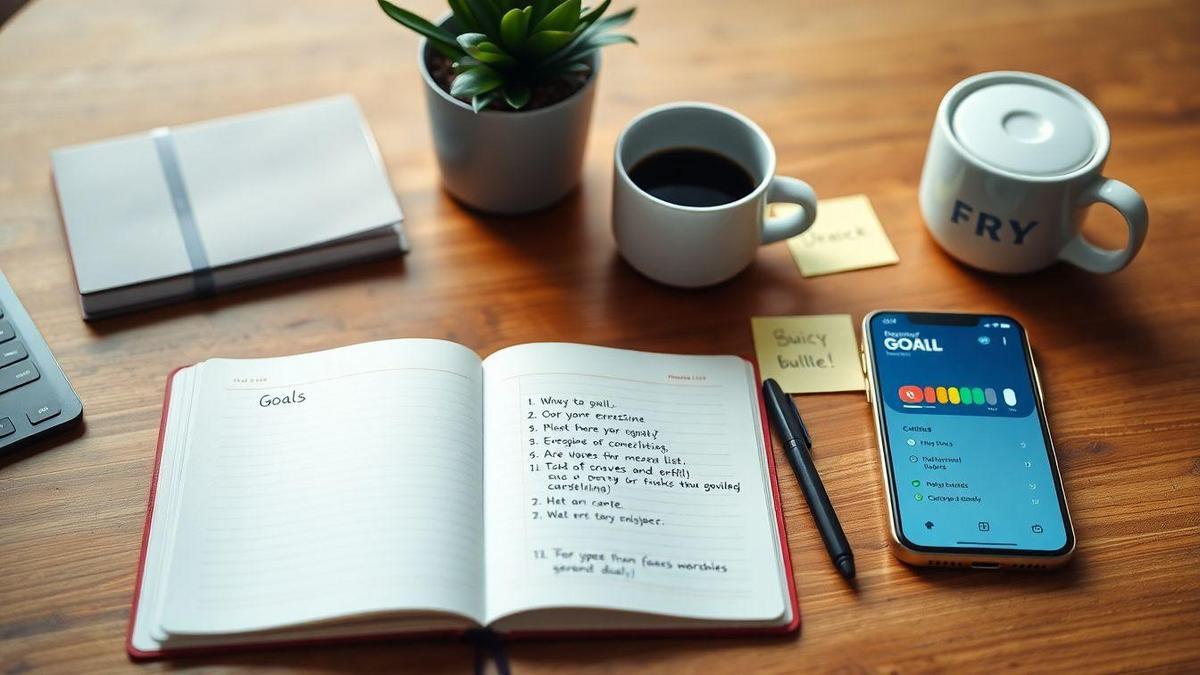
How I set goals and measure progress
When you ask “Guitar, keyboard, or drums: which one fits your style?” start with clear goals: small weekly steps and simple monthly targets.
- Weekly: short practice blocks, one song section, a speed target, or one recording.
- Monthly: finish a full song, reach a tempo, or record a demo.
| Timeframe | Focus | Example goal (Guitar / Keyboard / Drums) | Metric |
|---|---|---|---|
| Weekly | Technique & habit | 30 min daily; learn verse / practice scales / groove exercise | Minutes practiced; sections learned |
| Monthly | Finish & polish | Play 1 full song clean / play 3 songs with chords / record a drum loop | Songs finished; recordings made |
Track time with a log. Missed days = data, not failure.
Career vs hobby paths
Pick a path early; it shapes goals and gear. If you’re weighing natural ability against practice, consider the insights from talent vs practice: can anyone learn music? when setting milestones.
| Path | Short-term milestone | Weekly task |
|---|---|---|
| Teacher | Teach a 30-min lesson | Plan one lesson; teach friend |
| Session player | Play 5 standard songs | Learn one new song; record clean take |
| Home producer | Finish 1 track mix | Produce 2-min demo; learn one mixing move |
Monthly review checklist:
- Practice time: hit minutes goal? Adjust.
- Repertoire: how many songs ready? Add one or polish.
- Technique: improved? Repeat drills.
- Recording: usable demo? Record/edit.
- Gear: issues? Fix/tweak.
- Path: closer to Teacher/Session/Producer? Adjust tasks.
Mark items done, in progress, or redo.
Quick answer: Guitar, keyboard, or drums: which one fits your style?
Choose the instrument that matches the sound you love, your budget, and the time you’ll protect for practice:
- Pick Guitar for singing, portability, and fast wins.
- Pick Keyboard for harmony, songwriting, and studio work.
- Pick Drums for groove, energy, and driving a band.
Try each for 30 minutes before deciding.
Conclusion
Ask three questions: What sound do I love? What budget do I have? How much time can I practice? Answer those and the path — guitar, keyboard, or drums — becomes clear.
Treat choices like a map and practice like watering a plant: small, regular doses win. Pick what keeps you coming back. Fun fuels practice. Practice builds skill. Skill makes music happen.
For more guides, gear picks and routines, learn about our mission on the About page or contact us for specific questions.
Frequently asked questions
Q: Guitar, keyboard, or drums: which one fits your style?
A: Consider the music you love and how you want to participate. Guitar for singing and melody, keyboard for chords and production, drums for rhythm and energy. Try 30 minutes on each and pick the one you keep playing.
Q: How do I test each instrument fast?
A: Play one chord on guitar, one scale on keyboard, and tap a basic beat on drums. Note which felt easiest and most fun.
Q: What gear do I need to start?
A: Affordable, playable gear: an acoustic guitar, a small MIDI keyboard, or a practice pad/used drum kit. Buy used to save money and prioritize lessons and practice over flashy gear.
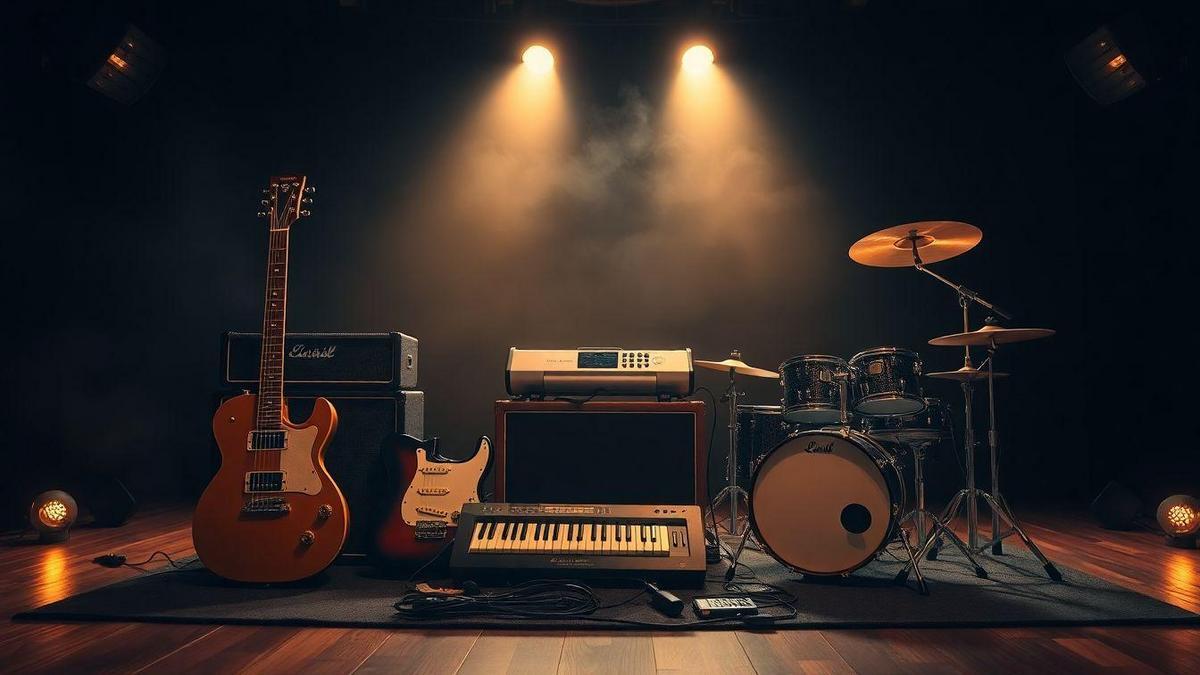
1 comentário em “Guitar keyboard or drums fit your style”